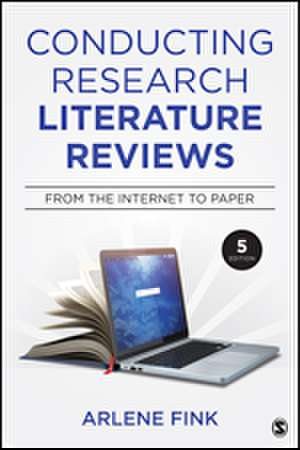Conducting Research Literature Reviews: From the Internet to Paper
Autor Arlene G. Finken Limba Engleză Paperback – 17 mar 2019
- New research, examples and references from the social, behavioural and health sciences
- Expanded coverage of qualitative research in every chapter
- Updates and revises meta-analysis procedures
- A brand new glossary of key terms
- Double the number of exercises and additional examples of how to write reviews
Preț: 536.21 lei
Preț vechi: 724.62 lei
-26% Nou
Puncte Express: 804
Preț estimativ în valută:
102.61€ • 109.72$ • 85.55£
102.61€ • 109.72$ • 85.55£
Carte disponibilă
Livrare economică 27 martie-10 aprilie
Livrare express 12-18 martie pentru 27.14 lei
Preluare comenzi: 021 569.72.76
Specificații
ISBN-13: 9781544318479
ISBN-10: 1544318472
Pagini: 304
Dimensiuni: 152 x 229 x 21 mm
Greutate: 0.41 kg
Ediția:Fifth Edition
Editura: SAGE Publications
Colecția Sage Publications, Inc
Locul publicării:Thousand Oaks, United States
ISBN-10: 1544318472
Pagini: 304
Dimensiuni: 152 x 229 x 21 mm
Greutate: 0.41 kg
Ediția:Fifth Edition
Editura: SAGE Publications
Colecția Sage Publications, Inc
Locul publicării:Thousand Oaks, United States
Recenzii
“Fink’s tone, level, and style is very approachable and understandable which makes it ideal for my students, most of whom are new to the process of literature reviews.”
“This book provides rich, useful, details on conducting literature review & constructing evidenced based reviews.”
“This book provides rich, useful, details on conducting literature review & constructing evidenced based reviews.”
Cuprins
Preface
Acknowledgments
About the Author
PART I. Research Design and Sampling
Chapter 1: Reviewing the Literature: Why? For Whom? How?
What is a Research Literature Review? Why Do One?
Gaining Control: Experiments and Observations
Systematic, Explicit, Comprehensive, and Reproducible: Four Key Words
Choosing an Online Bibliographic Database
How Do You Ask for Information? Searching With Boolean Operators
Pausing during the Search
Changing the Course of the Search
Supplementing the Online Search
Organizing the Research Literature: Building a Virtual Filing Cabinet
Chapter 2: Searching and Screening: The Practical Screen and Methodological Quality
Search Screen 1: The Practical Screen
Search Screen 2: Methodological Quality Screening Criteria
Observational Designs in Brief
A Note on Other Designs and Studies: Cross-Sectional Surveys and Consensus Statements
Internal and External Validity
Criterion for Quality: Sampling
The Sampling Unit
The Size of the Sample
Response Rate
PART II. Data Collection, Interventions, Analysis, Results, and Conclusions
Chapter 3: Searching and Screening: Methodological Quality
Data Collection and Data Sources: Methods and Measures
Interventions and Programs: Reviewing the Research Literature to Find out What Works
Data Analysis: Statistical Methods in the Research Literature
Accounting for Impact
Chapter 4: Doing the Review: A Reader’s Guide Chapter
Types of Information: Methods and Content
Eligibility and Actuality
Reporting Standards: Checklists for Research Writing and Reviewing
How TREND Was Used in a Literature Review
Reliable and Valid Reviews
Uniform Data Collection: The Literature Review Survey Questionnaire
Uniform Data Collection: Definitions and More
Pilot Testing the Review Process
Establishing Validity
Monitoring Quality
Chapter 5: What Did You Find? Synthesizing Results
Now that You Have Done It, What Do You Do With It?
Descriptive Syntheses or Reviews
Meta-Synthesis
Meta-Analysis
Meta-Analyses in Practice: Examples
Glossary
Author Index
Subject Index
Acknowledgments
About the Author
PART I. Research Design and Sampling
Chapter 1: Reviewing the Literature: Why? For Whom? How?
What is a Research Literature Review? Why Do One?
Gaining Control: Experiments and Observations
Systematic, Explicit, Comprehensive, and Reproducible: Four Key Words
Choosing an Online Bibliographic Database
How Do You Ask for Information? Searching With Boolean Operators
Pausing during the Search
Changing the Course of the Search
Supplementing the Online Search
Organizing the Research Literature: Building a Virtual Filing Cabinet
Chapter 2: Searching and Screening: The Practical Screen and Methodological Quality
Search Screen 1: The Practical Screen
Search Screen 2: Methodological Quality Screening Criteria
Observational Designs in Brief
A Note on Other Designs and Studies: Cross-Sectional Surveys and Consensus Statements
Internal and External Validity
Criterion for Quality: Sampling
The Sampling Unit
The Size of the Sample
Response Rate
PART II. Data Collection, Interventions, Analysis, Results, and Conclusions
Chapter 3: Searching and Screening: Methodological Quality
Data Collection and Data Sources: Methods and Measures
Interventions and Programs: Reviewing the Research Literature to Find out What Works
Data Analysis: Statistical Methods in the Research Literature
Accounting for Impact
Chapter 4: Doing the Review: A Reader’s Guide Chapter
Types of Information: Methods and Content
Eligibility and Actuality
Reporting Standards: Checklists for Research Writing and Reviewing
How TREND Was Used in a Literature Review
Reliable and Valid Reviews
Uniform Data Collection: The Literature Review Survey Questionnaire
Uniform Data Collection: Definitions and More
Pilot Testing the Review Process
Establishing Validity
Monitoring Quality
Chapter 5: What Did You Find? Synthesizing Results
Now that You Have Done It, What Do You Do With It?
Descriptive Syntheses or Reviews
Meta-Synthesis
Meta-Analysis
Meta-Analyses in Practice: Examples
Glossary
Author Index
Subject Index
Notă biografică
Descriere
Providing readers with an accessible, in-depth look at how to synthesize research literature, Conducting Research Literature Reviews: From the Internet to Paper is perfect for students, researchers, marketers, planners, and policymakers who design and manage public and private agencies, conduct research studies, and prepare strategic plans and grant proposals. Bestselling author Arlene Fink shows readers how to explain the need for and significance of research, as well as how to explain a study’s findings.
Offering a step-by-step approach to conducting literature reviews, the Fifth Edition features new research, examples, and references from the social, behavioral, and health sciences, expanded coverage of qualitative research, updated and revised meta-analysis procedures, a brand new glossary of key terms, double the number of exercises, and additional examples of how to write reviews.
Offering a step-by-step approach to conducting literature reviews, the Fifth Edition features new research, examples, and references from the social, behavioral, and health sciences, expanded coverage of qualitative research, updated and revised meta-analysis procedures, a brand new glossary of key terms, double the number of exercises, and additional examples of how to write reviews.
